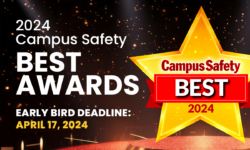How the Latest Access Control Technology Helps Secure Campuses
Access control solutions that are integrated and offer multiple credential options are great ways to protect your campus.

Advances in consumer electronic technology coupled with information available on the Internet have made it easy to clone and counterfeit traditional card credentials.
The following article originally ran in Campus Safety’s sister publication Security Sales & Integration.
Organizations that use electronic access control perform routine administrative tasks to manage the activity of their systems.
Basic system administration responsibilities like adding and deleting personnel, updating demographic information, changing access rights, and reporting require attention and effort on a regular basis.
When considering a specific market end user such as a higher-education campus, for example, one of the unique characteristics that makes access control more challenging than the traditional corporate enterprise is the student population turnover each semester.
In a campus setting, tens of thousands of students arrive at the start of each semester with the expectation of having the ability to move through their day with minimal issues – accessing classrooms, libraries, common areas and their residences.
Start-of-school-year activities such as issuing credentials to new students, replacing lost credentials and assessing enrollment status and housing assignments will undoubtedly change at the last minute, which adds to the hectic beginning of a semester.
Students and their parents want to feel safe, without being inconvenienced or feeling overly restricted. The need for well thought out policies and procedures to manage credentialing and access control is crucial to creating a friction-free security experience for the end user, while maintaining compliance and control.
Integrating Access Control Systems Is a Must
As a general best practice, the access control system should be integrated with the IT business systems containing employee and student information, so that the flow of data is automated, eliminating human error and reducing processing time.
If the access control system is the primary system for capturing photos and printing credentials, additional data from other systems such as the meal card or library codes may need to be imported and updated before the credential is created, allowing the data to be printed or encoded on the ID.
If the badges are created in another system, the card data and photos need to be imported into the access control system so that the student’s credentials start working immediately. If the card doesn’t work in a timely manner, chances are high that the student will have to make a return trip to the administration office, wasting time and resources.
Card Credentials of All Kinds Include Security Risks
The predominant credentials on campuses for many years have been 125kHz proximity cards and magnetic swipe readers. While the technology remains low cost and widely available, its weakness has been its simplicity.
Advances in consumer electronic technology coupled with information available on the Internet have made it very easy to clone and counterfeit those credentials. Even early generation 13.56MHz smart cards have been duplicated or hacked using commercially available devices.
Newer card technologies that use private or custom encryption keys reduce the risk of cards being cloned, but they aren’t without their own issues.
Having a custom encryption key guarantees that the cards are unique to the issuing institution, but it adds complexity in managing the keys and loading the encryption keys onto the readers.
Considering that the average lifespan of access control equipment is 10-15 years, changing technology takes time and comes with a significant cost. It isn’t always practical to upgrade an entire campus in a short period of time, so change can be slow.
Readers that can read both old and new credentials allow for new more secure credentials to be issued, while not requiring every student to get a new ID. Likewise, multitechnology cards allow a single card to be used with different readers during the transition to new technology.
Unfortunately, multitechnology cards and multitechnology readers don’t always work well together, so it is important to pick a strategy that is tested and proven to work, and adhere to a plan to avoid frustrating end users with long read times.
Mobile Technology Shows Promise, Without Compromise
Recently, mobile credentials have been introduced that allow a smartphone to be used as a credential for access control, eliminating the need for ID cards for physical access.
While it may not replace the need to have an ID card, [mobile credential] technology has the potential to make access control easier and more convenient without compromising security.
Using third-party software to generate certificates and transfer credentials between phones and application servers allows readers to grant access to users using only their phone. Available add-on reader modules or inline readers have made mobile credential technology accessible to all major smartphones.
They want and expect a smooth interaction with security technology. Campus security should be a foundational element of the student experience, not an afterthought.
Institutions that make investments in the security of their faculty, staff, and students will build a reputation of safety and be able to send that message to prospective students and families.
Brad Konkle is Director, Integrated Solutions for Stanley Security. Reach him at Brad.Konkle@sbdinc.com
Read Next: How IP Technology Can Streamline Multi-System Communications
If you appreciated this article and want to receive more valuable industry content like this, click here to sign up for our FREE digital newsletters!
 Leading in Turbulent Times: Effective Campus Public Safety Leadership for the 21st Century
Leading in Turbulent Times: Effective Campus Public Safety Leadership for the 21st Century
This new webcast will discuss how campus public safety leaders can effectively incorporate Clery Act, Title IX, customer service, “helicopter” parents, emergency notification, town-gown relationships, brand management, Greek Life, student recruitment, faculty, and more into their roles and develop the necessary skills to successfully lead their departments. Register today to attend this free webcast!













